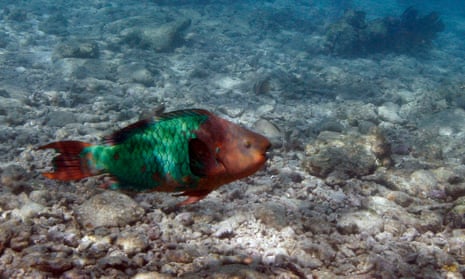The United States’ coral reefs are in fair condition, according to a recent reef condition status report, but vulnerable to decline. Scientists estimate that along the coast of Florida, where degradation is most severe, perhaps as little as 2% of original coral cover remains.
The report, released by the National Oceanic and Atmospheric Agency (Noaa) and the University of Maryland Center for Environmental Science last week, assesses reefs along the Atlantic and Pacific coasts, from the US Virgin Islands and Puerto Rico to Guam, Hawaii and American Samoa. It is the first of its kind to do so using standardized monitoring data on a national scale. Analyzing records from 2012 to 2018, researchers identify ocean warming and acidification, coral disease and fishing as ongoing threats to coral reefs, indicating a “dire outlook” for these ecosystems.
Coral reefs, widely considered the most biologically diverse ecosystem in the ocean, help to support over 25% of all marine life. They also provide shoreline protection against hurricanes and tropical storms, and economic benefit through commercial fishing, tourism and recreation.
Unlike years past, when experts credited ocean pollution with worsening coral reefs’ outlook, Noaa researchers now name climate change as the primary cause of reef degradation.
“It used to be mostly water quality … but now it’s pretty well accepted that it’s predominantly climate change,” says Jennifer Koss, director of Noaa’s coral reef conservation program.
The twin threats of temperature-related bleaching and increased ocean acidification, both caused by climate change, can destroy coral reef ecosystems regardless of their location or proximity to human populations. And along the Florida coast, additional stressors of water pollution, new development, overfishing and disease outbreaks mean that even remaining coral cover is inadequate and unhealthy.
“A lot of the corals that are left are what we refer to as the more weedy species,” says Erinn Muller, who specializes in coral health and disease at Mote Marine Laboratory in Sarasota, Florida. “They’re resistant to a lot of threats, but they’re not the major reef-building species and they’re not the species that are important for high levels of biodiversity … they’re functioning at a very different scale than they should be.”
Potential impacts are not solely environmental. Muller says Florida’s reef is estimated to be worth at least $8bn to the state economy, providing support for over 70,000 local jobs; a recent US Geological Survey report estimated that coral reefs provide almost $600m in infrastructure to the peninsula and over $75m to the Florida Keys every year.
In response to the threat of potential future decline, scientists are working to raise awareness and restore coral growth. Past efforts to replant coral reefs have been utilized in response to acute damage like a ship strike or a storm – now, researchers are using the same knowledge to help reverse the effect climate change has had on reef populations.
“If for whatever reason a forest is clearcut,” Koss says, referring to the practice by which trees are cut down or removed, “or it’s damaged by a fire or a tornado, nobody thinks twice about going back and replanting what was there. We’re really taking the same approach.”
National solutions could be on the way as well. The Restoring Resilient Reefs Act, introduced by lawmakers last year, would establish a federal taskforce on coral protection and a set of national strategies for reef management and restoration. It has been co-sponsored by lawmakers from Hawaii and Florida, where reefs are a critical part of state ecology and economy.
“We are at a critical point, [but] the trajectory can be reversed,” says Koss. “We’re not naive enough to think we can get all the reefs to where they were pre-industrial development … we’re doing everything we can to buy coral some time, so that they can assimilate and acclimate to their new conditions.”
In the long term, says Muller, scientific responses need to include not only local restoration efforts but also addressing the global impact of the climate crisis on water quality and the ecosystems that depend on it to survive.
She stresses the need to be proactive about preserving marine life, rather than simply reacting to each new blow dealt by the climate crisis. “We won’t be able to climate-proof these ecosystems forever.”
